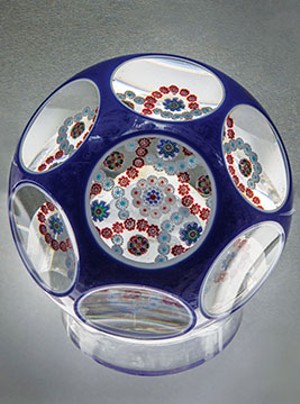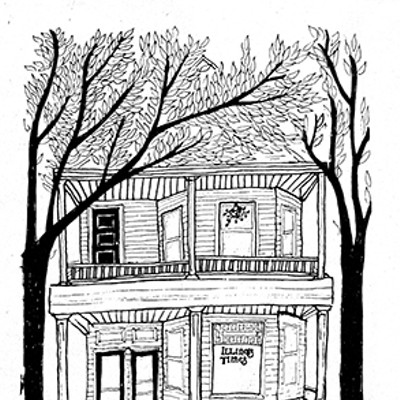
Paperweights can be things of beauty even to eyes not confused by sentiment. Among those reckoned by collectors to be the most beautiful are weights made in France in the mid-1800s. Leading glassworks such as Baccarat, Clichy and St. Louis began to make paperweights that tested the limits of what the craft could achieve, and what their customers could pay for. The result were wonders of the glassmaking art.
I confess that my contemplation of art glass in general is mostly 11-year-old kid “how-do-they-do-that?” admiration. The world record price of $258,000 was paid in 1990 for a Clichy “Basket of Flowers.” I wouldn’t have it on my desk for 10 bucks but it is an amazing object, in the same sense that Liberace was an astonishing object. A few years ago, at the Fogg Museum in Cambridge, Massachusetts, I saw a first edition copy of the famous Portland Vase by Wedgwood & Sons that left me gawping like reporters seeing Bruce Rauner’s state budget for the first time. I looked at it once, started to walk away, then went back to look at it again, and I still couldn’t quite believe what I saw.
If you don’t take my word for it – and why should you? – drop by that the Illinois State Museum at Edwards and First. There are displayed paperweights that belonged to Morton D. Barker of the venerable Springfield Barker clan. One never knows what might attract the eye of a rich man – apparently Barker didn’t when he bought a green magnum doorstop-type weight at an estate auction in St. Louis in the early 1940s. Over the years Barker, after much boarding of airplanes and opening of checkbooks, built a fine collection of 252 weights that included examples from the finest makers in the best period. Barker gave it to the museum in 1976.
Barker’s collection, dazzling as it is, shines hardly at all compared to Art Rubloff’s. That flamboyant Chicago real estate developer amassed 1,472 paperweights that comprise one of the three best collections in the world. Rubloff gave 1,200 of them to the Art Institute in 1978; more than 800 are on view today in recently enlarged space in what amounts to the museum’s basement.
Their presence in that august institution has elicited scorn from some visitors. Tribune reporter Steve Johnson in a 2011 article said of the display, “We can only presume [it] was to be part of a larger exhibit highlighting the desk implements of Chicago’s monied class. But somehow the Marshall Field Stapler Assemblage and the Tom Ricketts Gallery of Ornate Letter Openers got lost in the mail.”
Sounds like me when I’m in a mood.
Collecting antique glass paperweights does strike many people as absurd. It’s like billionaires collecting Republican congressmen – they cost a lot of money but they aren’t of much practical use. But of course the art-ness of such an object does not inhere in its function but in its making, as is shown by the AI’s ceramics galleries, which are filled with teapots and incense burners and serving platters and inkstands and other domestic gadgets elevated by their beauty.
Johnson did raise a point about how the hobbies of the rich become our hobbies too, whether we share their taste or not. Their presence in a great museum endows any object (and their collectors) with Importance, indeed defines what “art” is. Would an art museum curated by popular vote include antique glass? Not unless the glass once contained beer.
The Barker weights raise a different question. While there is no question the Barker paperweights belong in a museum, do they belong in this museum? The Illinois State Museum is a museum of Illinois stuff – it would have been better named the State Museum of Illinois – and these objects aren’t. Happily, such fine distinctions matter little at the ISM, which is a people’s wunderkammer – a gift to the people who have (mostly) paid for it from a government that for the moment still believes that the world’s treasures shouldn’t all belong to the rich.
Contact James Krohe Jr. at [email protected].





















